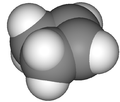Cyclobutene (original) (raw)
From Wikipedia, the free encyclopedia
Cyclobutene
  |
|
|---|---|
| Names | |
| Preferred IUPAC name Cyclobutene | |
| Identifiers | |
| CAS Number | 822-35-5  Y Y |
| 3D model (JSmol) | Interactive image |
| ChEBI | CHEBI:51206  Y Y |
| ChemSpider | 63164  Y Y |
| ECHA InfoCard | 100.011.360 |
| EC Number | 212-496-8 |
| PubChem CID | 69972 |
| CompTox Dashboard (EPA) | DTXSID60231616 |
InChI InChI=1S/C4H6/c1-2-4-3-1/h1-2H,3-4H2  YKey: CFBGXYDUODCMNS-UHFFFAOYSA-N YKey: CFBGXYDUODCMNS-UHFFFAOYSA-N  YInChI=1/C4H6/c1-2-4-3-1/h1-2H,3-4H2Key: CFBGXYDUODCMNS-UHFFFAOYAN YInChI=1/C4H6/c1-2-4-3-1/h1-2H,3-4H2Key: CFBGXYDUODCMNS-UHFFFAOYAN |
|
| SMILES C\1=C\CC/1 | |
| Properties | |
| Chemical formula | C4H6 |
| Molar mass | 54.092 g·mol−1 |
| Appearance | Colorless gas |
| Density | 0.733 g/cm3 |
| Boiling point | 2 °C (36 °F; 275 K)[1] |
Except where otherwise noted, data are given for materials in their standard state (at 25 °C [77 °F], 100 kPa).  Y verify (what is Y verify (what is  Y Y N ?) Infobox references N ?) Infobox references |
Chemical compound
Cyclobutene is an organic compound with the chemical formula C4H6. It is a cycloalkene. It is a colorless gas that easily condenses. It is of interest in research but currently has no practical applications. A modern synthesis involves the 2-step dehydration of cyclobutanol.[1] The compound was first prepared by thermolysis of the ammonium salt [C4H7N(CH3)3]OH (cyclobutyltrimethylammonium hydroxide).[2]
Cyclobutene thermally isomerizes to 1,3-butadiene. This strongly exothermic reaction reflects the dominance of ring strain. In contrast, the corresponding equilibrium for hexafluorocyclobutene disfavors hexafluorobutadiene.[3]
- ^ a b J. Salaün; A. Fadel (1986). "Cyclobutene". Org. Synth. 64: 50. doi:10.15227/orgsyn.064.0050.
- ^ Willstätter, R.; von Schmaedel, W. (1905). "Ueber einige Derivate des Cyclobutans". Chem. Ber. 38 (2): 1992–1999. doi:10.1002/cber.190503802130.
- ^ David M. Lemal; Xudong Chen (2005). "Fluorinated Cyclobutanes and Their Derivatives". In Zvi Rappoport; Joel F. Liebman (eds.). The Chemistry of Cyclobutanes. PATAI'S Chemistry of Functional Groups. pp. 955–1029. doi:10.1002/0470864028.ch21. ISBN 0470864001.